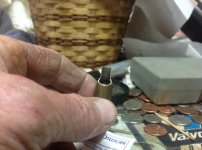C
Chris M
Guest
I have attached a pic of a case fired in my new 6PPC rifle, out of sixty cases fired, seven have developed cracks at the base of the necks, these cases are on their third firing from new. Chamber is .262 neck and cases are turned to .0085 thickness. Berger Column bullets and 29grains of N133.
Any ideas anyone?
Regards
Chris
Attachments
Last edited by a moderator:




